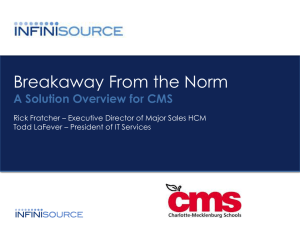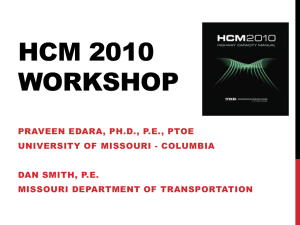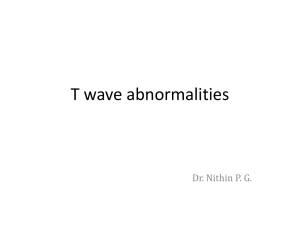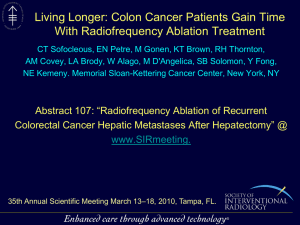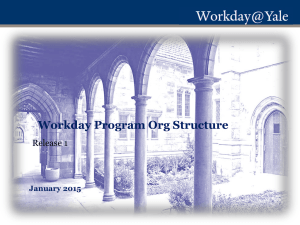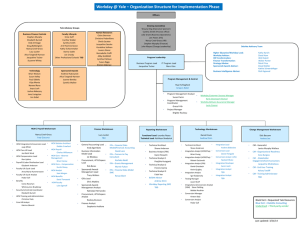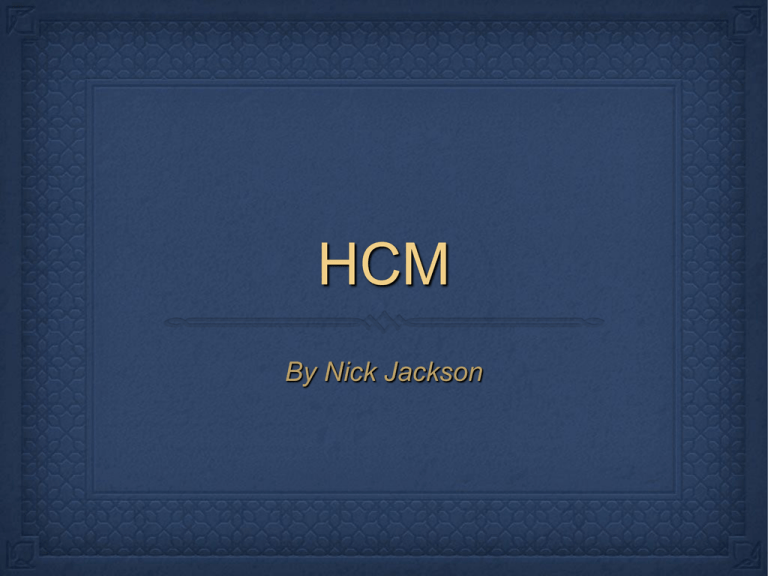
HCM
By Nick Jackson
Case
71 year old man who initially presented to his
GP in the year 2000 with lethargy and SoB.
Could previously fit as a fiddle, then he found he
was SoB on walking down the street.
He then had a number of tests ordered...
Routine bloods, TFTs, Stress sestamibi, sleep
study, spirometry (none of which were very
conclusive).
Past History
Rheumatic heart disease as a child (spent nine
months in bed).
Partial gastrectomy for duodenal ulceration in
1986. Severe diarrhoea and weight loss since.
Iron deficiency likely related to this but awaiting
Inv with scopes.
Non-smoker, drinks 2 standard drinks a day.
Father died suddenly at age 75.
Examination
AFeb. Pulse 80 (SR). BP 140/76.
Chest: Clear.
Heart sounds: Dual + PSM (lessens with
squatting).
Mild peripheral oedema.
History
Admitted to hospital in 2004 with CP, turned out to have
cholecystitis (had his gall bladder out soon after).
In 2008 he was admitted under cardiology with a possible
infarct.
TTE
TTE
QuickTime™ and a
YUV420 codec decompressor
are needed to see this picture.
TTE
QuickTime™ and a
YUV420 codec decompressor
are needed to see this picture.
TTE
QuickTime™ and a
YUV420 codec decompressor
are needed to see this picture.
TTE
QuickTime™ and a
YUV420 codec decompressor
are needed to see this picture.
TTE
QuickTime™ and a
YUV420 codec decompressor
are needed to see this picture.
TTE
QuickTime™ and a
YUV420 codec decompressor
are needed to see this picture.
TTE
QuickTime™ and a
YUV420 codec decompressor
are needed to see this picture.
TTE
QuickTime™ and a
YUV420 codec decompressor
are needed to see this picture.
LV Gram
Normal coronary arteries.
Management
After a diagnosis of HCM with obstruction was
made he was titrated up to a verapamil dose of
480mg daily.
A year later a TTE showed a resting LVOT
gradient of 60mmHg.
Still substantially SoB, despite medication.
How do you manage this man?
HCM Recommendations
Defined as LVH (maximal wall thickness ≥15mm)
without LV dilatation and without cardiac or systemic
conditions that can explain the extent of hypertrophy.
It affects around 0.2% of the population in the US.
A resting or exercise outflow tract gradient is present
in 70% of HCM patients and significant outflow tract
obstruction at rest (present in 20-30%) is an
independent predictor of mortality (adjusted RR of 1.6
for death).
(6)
this condition live a normal life expectancy.
Consequences include SCD, dynamic outflow
tract obstruction with associated MR, AF and
thromboembolic complications.
HCM Recommendations
Clinical screening with ECG and TTE is
recommended for all first degree relatives of
patients with HCM (class I).
(6)
HCM Recommendations
Genetic testing is not recommended unless the
index patients has a defined pathogenic
mutation (class III).
The usefulness of pharmacotherapy for HCM is
unclear (class IIb).
Septal reduction therapy should not be
considered for asymptomatic patients regardless
of their LVOT gradient (class III).
(6)
HCM Recommendations
Beta blockers to achieve a resting heart rate of
60-65 bpm is recommended for the treatment of
angina or dyspnoea in patients with HCM or
HOCM. Verapamil should be considered if Beta
Blockers are not tolerated or contraindicated
(class I).
Dihydropyridine CCBs, digitalis in the absence
of AF and positive inotropes are all potentially
harmful in patients with HCM (class III).
(6)
HCM Recommendations
Septal ablation should be considered only in
patients with severe, drug refractory symptoms
and a resting or provoked LVOT gradient of at
least 50mmHg (class I). Alcohol septal ablation
can be considered in those with serious comorbidity or a strong aversion to surgery (IIa).
(Around 5% of all HCM patients and 30% at
tertiary referral centres require non-medical
therapy).
(6)
HCM Recommendations
ICD therapy is recommended in patients with
prior cardiac arrest or sustained VT (class I), in
patients with a history of SCD in a first degree
relative, marked LVH or recent unexplained
syncope (class IIa) or an abnormal blood
pressure response to exercise (class IIa or IIb,
depending on other risk modifiers such as
marked LVOT obstruction).
(6)
HCM Recommendations
HCM patients should not participate in intense
competitive sports (eg. basketball, soccer,
tennis), whether or not they have LVOT
obstruction, prior septal reduction or an ICD
(class III).
(6)
Septal Myectomy
3-15 gms of septal muscle is removed by the
surgeon via an approach through the aortic
valve (aortotomy).
Text
The region of septum to remove is that adjacent
to the point of mitral septal contact
(intraoperative TOE is needed).
This septal myectomy can be extended and
mitral subvalvular anomalies can also be
repaired at the same time.
(1)
Septal Myectomy
Perioperative mortality at expert centres is of the
order of 0.8% (Toronto General and Cleveland
clinic). With a concomitant surgical procedure
(CABG, MVR) the 30 day mortality is around 3.4%.
Complications include VSD (around 2% in a
Toronto General study). More common in patients
with comparatively thin septums.
The hypertrophied myocardium is vulnerable to
ischaemia which can lead to LV dysfunction at a
later date.
(1)
Septal Myectomy
Traction on the aortic valve during surgery may
lead to AR of varying severity. 4% in one series
had significant AR.
A small AV annulus or a low MV septal contact
point were present in all of these patients.
CHB requiring a PPM occurs in 5-10% of cases.
The risk is lower in patients with a normal QRS
at baseline (~1%).
(1)
Outocmes
Surgical myectomy results in resolution of symptoms
and LVOT gradient in almost all patients.
It may also reduce MR in patients without independent
mitral valve disease., improve myocardial perfusion,
reduce LVEDP and left atrial size and regress
hypertrophy of other myocardial segments.
Survival in a Mayo clinic series was 98, 96 and 83% at
one, five and ten years post surgery (not different form
patients with non-obstructive HCM or matched controls
from the general population).
(1)
Outcomes
‘Outcome of patients with hypertrophic
obstructive cardiomyopathy after percutaneous
transluminal septal myocardial ablation and
septal myectomy surgery’ JACC 2001.
Of 51 patients with HCM 25 were treated with
PTSMA and 26 with myectomy in a nonrandomised fashion. The PTSMA group had a
greater incidence of htn and of co-morbid illness.
(2)
Gradients
(a) Alcoholic ablation (b) Surgical
Myectomy.
(2)
Gradients
(a) Alcoholic ablation (b) Surgical
Myectomy.
(2)
Gradients
(2)
NYHA class
(2)
Outcomes
‘Long term effects of surgical septal myectomy
on survival in patients with obstructive
hypertrophic cardiomyopathy’ JACC 2005
Total and HCM related mortality were compared
in three subgroups of 1,337 consecutive HCM
patients from 1983 to 2001. Surgical myectomy
(289), LVOT obstruction without operation (228)
and non-obstructive HCM (820).
(3)
(3)
Survival
(3)
Survival
(3)
Survival
(3)
Outcomes
Independent predictors of overall mortality were
concomitant CABG, pre-operative history of AF,
pre-operative left atrial diameter ≥46mm, age >50
and female gender in a Toronto General study that
showed similar survival rates to the Mayo clinic
series.
A mitral valvuloplasty in patients with elongated
leaflets can be performed at the same time as
septotomy. MV replacement is generally only done
if there is concurrent independent MV pathology.
(1)
Pacing
Early observational studies and small RCTs
suggested that pacing may be beneficial by
creating septal dys-synchrony.
Subsequent larger RCTs (M-PATHY)
demonstrated average LVOT gradient reductions
of ~50% without good symptomatic improvement.
The 2008 ACC guidelines accordingly
recommend pacing in HCM primarily where there
in sinus node disease or AV block.
(1)
Pacing
A subset of primarily older patients with localised mild
to moderate septal hypertrophy may benefit, however.
Best considered when there are contraindications to
surgery and septal/MV anatomy is not suitable for
alcohol ablation.
The RV pacing lead must be at the apex and must
activate most of the LV myocardium before the native
complex does.
Short AV delays will often lead to AV dys-synchrony
with contraction of the atrium against a closed MV
leading to pulmonary congestion, poor filling and
(1)
M-PATHY (Circ ’99)
Prospective multicentre trial assessed pacing in
48 symptomatic HCM patients with ≥50mmHg
LVOT gradient.
Pts were randomised to 3 months each of DDD
pacing or AAI-30 pacing (control) in a double
blind cross-over study design. This was followed
by an uncontrolled and unblinded 6 month
pacing period.
(4)
Patient Groups
(4)
LVOT Gradients
(4)
(4)
(4)
M-PATHY Subgroup
6 pts (12%) on retrospective analysis showed a beneficial
response to pacing.
NYHA class dropped ≥1, QoL score increase >10, ≥10%
increase in treadmill exercise time and peak VO2.
Responders were 69+/- 4 vs 51+/- 16 tears of age. In five
of these pts LVOT gradient dropped by 35-40mmHg,
maximum wall thickness was moderate (17-23mm).
Several other parameters including PR interval were not
significant;y different. (HCM is a heterogeneous disease).
(4)
Alcohol septal ablation
Infarction and thinning of the proximal interventricular
septum via infusing alcohol into the first septal
perforator.
Proposed mechanism of benefit is improvement in LV
relaxation and compliance via a reduction in regional
asynchrony, resulting in an increased LV passive filling
volume and reduced LA size and LV ejection force.
In the longer term septal scarring occurs, increasing
LVOT diameter and leading to ‘therapeutic
remodelling’. An increased LV size and decreased LV
mass/hypertrophy and alteration of septal activation
occurs leading to incoordinate contraction.
(1)
Alcohol septal ablation
A reduction in non-septal mass over time may
suggest hypertrophy in HCM is in part afterload
dependent and not entirely genetic. Or alcohol
may damage other areas of the myocardium.
A meta-analysis of 42 observational studies
(2959 patients, mean age 54) and a mean follow
up of 13 months (Journal of interventional
cardiology 2006):
(1)
Baseline
characteristics
(5)
Haemodynamics
(5)
TTE features
(5)
LVOT Gradients
(5)
NYHA/CCS Class
(5)
Complications
(5)
Alcohol septal ablation
Individual studies suggest alcohol ablation may be
useful in patients with no resting gradient but a
provocable gradient of ≥30 mmHg.
Some patients who do not show initial benefit can
respond late and develop a reduced gradient at three
months.
Myocardial contrast echocardiography can accurately
show the size of septal vascular territory and predict
infarct size from alcohol ablation. In some series the
use of MCE has been associated with greater success
and less complications.
(1)
Complications
CHB requirring a PPM occurs in 14-25% of patients.
LBBB or first degree AV block prior to the procedure
are significant predictors. As are injection by bolus, no
use of MCE, injection of >1 septal artery and female
sex.
The benefits of alcohol septal ablation are not
diminished in patients who experience CHB.
Other complications include ventricular arrhythmias,
coronary dissection, pericardial effusion and rarely late
myocardial infarction due to escape of ethanol from
(1)
the target vessel.
Myectomy vs Alcohol ablation
In an observational study of 48 pts half underwent
myectomy and half alcohol ablation. Baseline groups
were reasonably matched apart from age (mean 62
vs 50 respectively).
Surgical myectomy consistently resulted in removal
of the obstructing portion of the anterobasal septum,
while in 25% of pts who underwent alcohol ablation
there was sparing of the proximal basal septum at
MRI and residual gradients at follow up.
(1)
Clinical outcomes
In a meta-analysis of trials of 351 symptomatic HCM pts,
baseline LVOT gradients were similar (81 and 77mmHg)
and pts in the alcohol ablation group were older (mean 54
versus 45 years).
At a mean of two years: In hospital mortality was not
significantly different (0.6 vs 1.6%). Improvement in NYHA
class was also similar (mean reduction 1.3 vs 1.5).
Surgical technique was associated with less PPM
insertion (3.3 vs 18.4%), an on average 6.6mmHg lower
mean LVOT gradient and a lower rate of repeat procedure
(1)
for recurrent obstruction (0.6 vs 5.5%).
Surgical myectomy
advantages
Higher success in relieving resting and provoked
obstruction (90-95% vs 80-90%).
Immediate relief of obstruction as opposed to a delay
of up to 3 months.
Lower CHB requiring PPM (3% vs 10-15% with newer
techniques).
Better symptom resolution in pts less than 65 yo.
Proven long term efficacy (>20 years).
(1)
Surgical myectomy
advantages
No risk of coronary dissection and minimal risk of
myocardial damage away from the septum.
Ability to treat concomitant problems (MV disease,
mid-ventricular obstruction, constricting muscle
bridges or RVOT obstruction.
Myectomy may reduce the risk of SCD and
appropriate ICD discharges, while this evidence is
lacking in alcohol ablation.
Survival benefit suggested with surgical ablation has
not been demonstrated with alcohol ablation.
(1)
Alcohol ablation
advantages
Avoidance of sternotomy and cardiopulmonary
bypass and their associated risks.
Shorter hospital stay and recovery time.
For older patients there is less risk of stroke with
alcohol ablation than myectomy.
CAD requiring percutaneous intervention can be
treated.
Less expense.
(1)
Management
? Stress TTE done.
Negative HCM genetic screen.
Had a dual chamber ICD inserted.
Relatively instantly became less SoB and LVOT
gradient dropped to 30mmHg so alcohol septal
ablation was not performed.
Now does 1km on the bike, leg presses 110 kgs,
rowing machine etc...
References
1. McKenna WJ. Nonpharmacologic treatment of outflow obstruction in hypertrophic cardiomyopathy. UpToDate Online. June 2009.
2. Qin JX, Shiota T, Lever HM, et al. Outcome of patients with hypertrophic obstructive cardiomyopathy after percutaneous transluminal
septal myocardial ablation and septal myectomy surgery. J Am Coll Cardiol 2001; 38:1994.
3. Ommen SR, Maron BJ, Olivotto I, et al. Long-term effects of surgical septal myectomy on survival in patients with obstructive
hypertrophic cardiomyopathy. J Am Coll Cardiol 2005; 46:470.
4. Maron BJ, Nishimura RA, McKenna WJ, et al. Assessment of permanent dual-chamber pacing as a treatment for drug-refractory
symptomatic patients with obstructive hypertrophic cardiomyopathy. A randomized, double-blind, crossover study (M-PATHY).
Circulation 1999; 99:2927.
5. Alam M, Dokainish H, Lakkis N. Alcohol septal ablation for hypertrophic obstructive cardiomyopathy: a systematic review of published studies. J
Interv Cardiol 2006; 19:319.
6. Bernard J. Gersh, Barry J. Maron, Robert O. Bonow, Joseph A. Dearani, Michael A. Fifer, Mark S. Link, Srihari S. Naidu, Rick A.
Nishimura, Steve R. Ommen, Harry Rakowski, Christine E. Seidman, Jeffrey A. Towbin, James E. Udelson, and Clyde W. Yancy2011
ACCF/AHA Guideline for the Diagnosis and Treatment of Hypertrophic Cardiomyopathy: A Report of the American College of
Cardiology Foundation/American Heart Association Task Force on Practice Guidelines Developed in Collaboration With the American
Association for Thoracic Surgery, American Society of Echocardiography, American Society of Nuclear Cardiology, Heart Failure Society
of America, Heart Rhythm Society, Society for Cardiovascular Angiography and Interventions, and Society of Thoracic SurgeonsJ. Am.
Coll. Cardiol., December 13/20, 2011.


